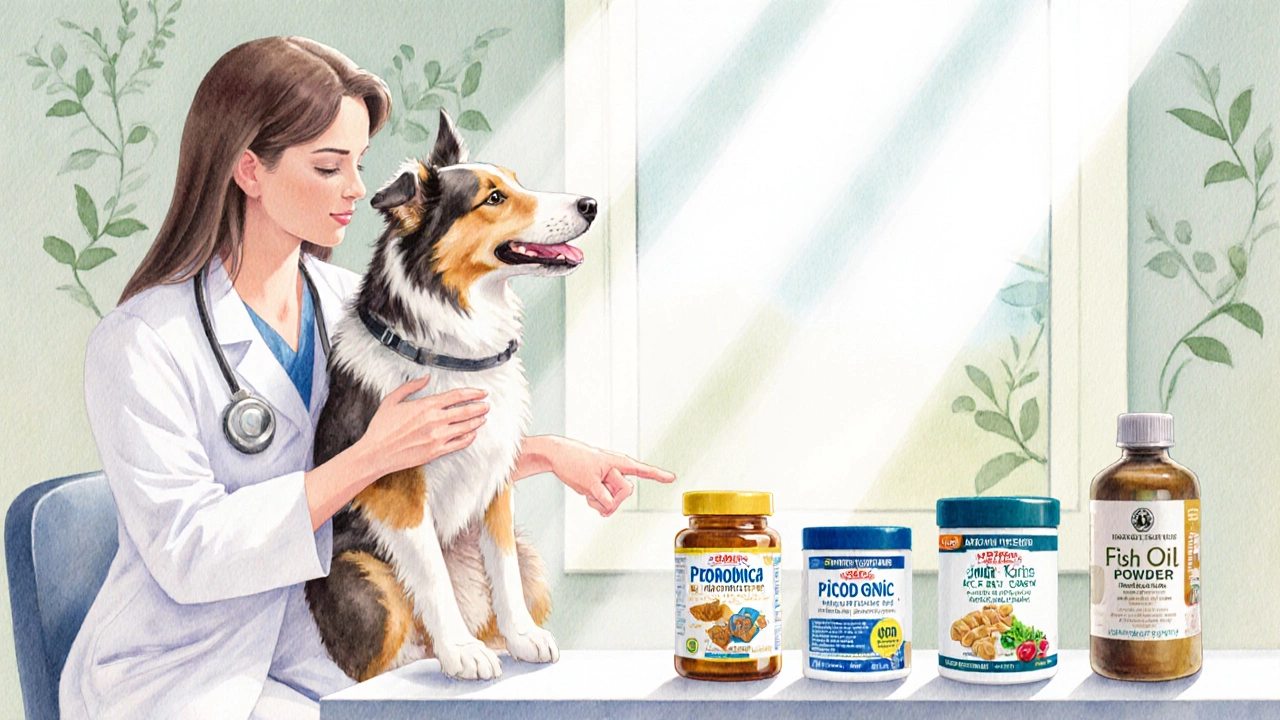Dog Supplement Age Calculator
Your Dog's Details
Recommended Supplements
Enter your dog's age and breed size to see recommended supplements
Wondering when the right moment is to slip a supplement into your dog’s diet? It’s a common question for new pet parents, especially when they hear about joint boosters for senior labs or skin‑coat oils for glossy coats. The answer isn’t a one‑size‑fits‑all number; it depends on the breed, growth rate, and overall health. Below you’ll find a step‑by‑step guide that tells you exactly what to look for at each stage of a dog’s life, how to pick the right product, and the red flags to avoid.
Key Takeaways
- Most healthy puppies don’t need supplements before 6 months unless a vet recommends them.
- Targeted supplements (joint, skin, probiotics) can start as early as 8‑10 weeks for specific needs.
- Senior dogs (7 years+ for large breeds, 9 years+ for small breeds) benefit from joint‑support and antioxidant formulas.
- Always choose supplements that list the active ingredient first, have third‑party testing, and match the dog’s life‑stage.
- Keep a simple checklist: vet advice, dosage, ingredient list, and monitoring plan.
What Are Dog Supplements? A dog supplement is a concentrated source of nutrients-vitamins, minerals, fatty acids, or functional compounds-designed to complement a balanced diet.
Unlike regular dog food, which already contains a blend of essential nutrients, supplements fill gaps that arise from genetics, lifestyle, or health conditions. They come in chews, powders, liquids, and even soft gels. The market is crowded, but not every product is created equal.
Why Age Matters
Dogs grow at dramatically different rates than humans. A 12‑week‑old Labrador can be the size of a six‑month‑old human toddler, while a giant breed like a Great Dane may not finish most of its skeletal development until 18‑24 months. Because nutrients support growth, immune function, and tissue repair, giving a supplement too early can overload immature organs, whereas waiting too long can let deficiencies worsen.

Age Milestones & Supplement Recommendations
- 0-8 weeks (Neonatal): Mother’s milk provides all needed nutrients. No supplements unless a veterinarian diagnoses a specific deficiency.
- 8-16 weeks (Weaning): Puppies start solid food. This is the first window to consider a multivitamin if the kibble is grain‑free or homemade and lacks a complete nutrient profile. Look for products that list vitamins A, D, E, and B‑complex in the first three ingredients.
- 4-6 months (Rapid Growth): Large‑breed puppies benefit from controlled calcium and phosphorus levels to avoid developmental orthopedic disease (DOD). A calcium supplement is rarely needed if you feed a reputable large‑breed formula, but a joint‑support blend containing glucosamine and chondroitin can be introduced for breeds prone to hip dysplasia.
- 6-12 months (Adolescence): Immune‑boosting probiotics become useful, especially if the dog has a history of digestive upset. A once‑daily dose of Omega‑3 (EPA/DHA) supports brain development and a shiny coat.
- 1-3 years (Adult): Most healthy adults don’t need routine supplementation. Focus shifts to preventive care-antioxidant blends (vitamin C, selenium) for active working dogs, or joint formulas for early wear‑and‑tear in large breeds.
- 4-7 years (Mature): Begin monitoring joint health. If you notice stiffness after walks, add a joint supplement with MSM (methylsulfonylmethane) and green‑lipped mussel extract.
- 7+ years (Senior for large breeds) / 9+ years (Senior for small breeds): Full‑spectrum senior formulas become valuable-combining joint support, antioxidants, and often a mild source of glucosamine. Skin/coat supplements with biotin and omega‑3 help counter age‑related dryness.
Remember, these are guidelines, not hard rules. Always run a quick check with a veterinarian before adding anything new.
Common Supplement Types and When to Start
| Supplement | Key Ingredient | Typical Starting Age | Primary Benefit |
|---|---|---|---|
| Multivitamin | Vitamins A, D, E, B‑Complex | 8-16 weeks (if diet incomplete) | Fill nutritional gaps |
| Probiotics | Live Lactobacillus cultures | 6 months+ | Gut health, immunity |
| Omega‑3 (Fish Oil) | EPA/DHA | 4-6 months | Skin, coat, brain development |
| Joint Support | Glucosamine, Chondroitin, MSM | 4-6 months (large breeds) or 1 year (others) | Joint cartilage, mobility |
| Calcium/Phosphorus | Calcium carbonate, Phosphorus | Only under vet guidance | Bone growth (large breeds) |
| Senior Formula | Glucosamine, Antioxidants, Biotin | 7 years (large) / 9 years (small) | Overall vitality, joint health |
How to Choose a Safe and Effective Supplement
- Check the label hierarchy. The active ingredient should be listed among the first three components. If it appears near the bottom, the dose is likely too low to be effective.
- Look for third‑party testing. Certifications from NSF, USP, or Informed‑Choice indicate the product has been screened for contaminants.
- Match the life‑stage. Many brands label their products as "Puppy," "Adult," or "Senior." Choose the one that aligns with your dog’s age and size.
- Watch for fillers. Avoid products loaded with artificial colors, flavors, or excessive grain mash-it often signals low‑quality manufacturing.
- Consult your vet. Even a supplement with perfect credentials can interact with medications or exacerbate a condition.

Risks of Over‑Supplementation
Giving a supplement when it’s not needed can lead to vitamin toxicity. For example, too much vitamin A can cause bone deformities in growing puppies, while excess calcium may trigger kidney stones. Fat‑soluble vitamins (A, D, E, K) accumulate in the liver. If you notice symptoms such as vomiting, lethargy, or abnormal gait after starting a new product, stop it immediately and seek veterinary care.
Practical Checklist for Pet Owners
- Ask your veterinarian for a baseline bloodwork panel.
- Identify any specific health concerns (joint pain, skin issues, digestive upset).
- Choose a supplement that lists the target nutrient first and matches your dog’s age.
- Measure the dose exactly as the label indicates-use a milligram scale for powders if needed.
- Record the start date, dosage, and any observed changes in a simple log.
- Re‑evaluate every 3-6 months with your vet, adjusting or stopping the product as the dog matures.
Following this routine helps you stay proactive without overloading your pup’s system.
Frequently Asked Questions
Do puppies need supplements if they eat premium kibble?
Most premium kibble is formulated to meet AAFCO nutritional standards for each life stage, so healthy puppies usually don’t need extra vitamins. A supplement may be useful only if the kibble is grain‑free, homemade, or the vet spots a specific deficiency.
Can I give my adult dog a puppy multivitamin?
It’s not recommended. Puppy formulas contain higher calcium and vitamin D levels that can stress an adult dog’s kidneys and bones.
What’s the safest way to add fish oil to a dog’s diet?
Choose a product specifically made for dogs, check that it’s purified to remove mercury, and start with a low dose (e.g., 250 mg EPA/DHA per 10 lb body weight). Mix it into wet food or a treat to mask the fishy taste.
How do I know if a joint supplement is working?
Look for improvements in mobility: easier stair climbing, reduced limping after walks, and a willingness to play longer. Keep a simple before‑and‑after log for 4‑6 weeks to track changes.
Are natural herbal supplements safe for dogs?
Herbs like turmeric or ginger can be beneficial, but dosage matters. Some herbs interact with blood thinners or anti‑inflammatory drugs. Always discuss herbal options with your vet before use.
Ultimately, the best age to start dog supplements hinges on a clear health need, a reputable product, and professional guidance. By following the age milestones, checking labels carefully, and keeping a log, you’ll give your canine companion the nutritional boost they truly need-no more, no less.







